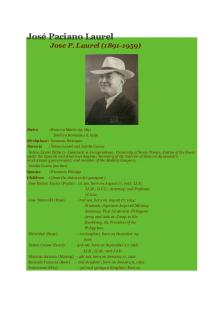Physiology - Professor was Laurel Roberts. PDF

| Title | Physiology - Professor was Laurel Roberts. |
|---|---|
| Author | Eva Brady |
| Course | Biology 1 |
| Institution | University of Pittsburgh |
| Pages | 3 |
| File Size | 147.9 KB |
| File Type | |
| Total Downloads | 69 |
| Total Views | 127 |
Summary
Professor was Laurel Roberts. ...
Description
• • • • •
•
•
• •
Physiology List the four types of animal tissues and describe the significant functions and structures of those discussed in class Explain how body size and surface area affect the metabolism of organisms Describe the mechanisms that organisms use to maintain homeostasis; countercurrent exchange and negative feedback The 10 organ systems in an animal contain each of the 4 tissue types • Nervous, muscle, epithelial, connective Nervous tissue is comprised of neurons that transmit information and glial cells that provide support • Neurons• Axons • Dendrites • Peripheral and central (CNS) • Sensory, motor, interneuron • Glial • Support • Protection • Glial cells are mitotically active while neurons are not. Which is more likely to become cancerous? Muscle tissue • Cardiac • Skeletal • Smooth Connective tissue is comprised of cells embedded in a matrix • Loose • Packaging and padding • Adipose • Padding and energy storage • Dense • Ligaments and tendons • Bone • Hard extracellular matrix • Cartilage • Flexible support • Blood • Fluid and extracellular matrix is plasma The palmaris longus is a vestigial structure found in about 85 % of humans Epithelial tissues form barriers and exchange surfaces • Quick turnover • Body surface and glands • Classified by shape and layers • Why does epithelial tissue line the gut and respiratory tract?
•
Mass-specific metabolic rate is inversely proportional to mass o Surface area/volume ratio: SA = L2, V = L3 o Calculate the volume of a cube with L = 3 µm. o Calculate the volume of a cube with L = 1 µm. o Which one will release material from the interior more efficiently?
•
Homeostasis is the maintenance of the internal environment, usually through negative feedback o Positive feedback o Negative o Sensor, integrator, and effector o Requires specialization of cells that dedicated to these functions => Another cost of evolving from unicellular to multicellular life Walter cannon described the four postulates that underpin the study of physiology o 1992 coined the term “homeostasis” and described the methods of maintaining it: Role of the nervous system in preserving the “fitness” of the internal environment 2. Tonic level of activity
•
•
3. Antagonistic controls for same parameters 4. Chemical signals have different effects on different tissues Countercurrent exchange allows organisms to maximize exchange of oxygen or heat between fluids o Oxygen, Heat, Water & salt (kidney) o Concurrent exchange would maximize at an equilibrium value of 60% o COUNTERcurrent exchange increases end value to 100% o...
Similar Free PDFs

Bárbara Millicent Roberts
- 7 Pages

Howard Roberts Guitar Book
- 49 Pages

La Rotonda del Laurel
- 1 Pages

ECON 130 Roberts Michael
- 5 Pages

embryology Dr Alice Roberts
- 16 Pages

Sciencie Fiction- Adams Roberts
- 216 Pages

Notes - Angela Roberts
- 20 Pages

Treatment - Angela Roberts
- 27 Pages

Physiology
- 85 Pages

jose p laurel life works and writing
- 24 Pages
Popular Institutions
- Tinajero National High School - Annex
- Politeknik Caltex Riau
- Yokohama City University
- SGT University
- University of Al-Qadisiyah
- Divine Word College of Vigan
- Techniek College Rotterdam
- Universidade de Santiago
- Universiti Teknologi MARA Cawangan Johor Kampus Pasir Gudang
- Poltekkes Kemenkes Yogyakarta
- Baguio City National High School
- Colegio san marcos
- preparatoria uno
- Centro de Bachillerato Tecnológico Industrial y de Servicios No. 107
- Dalian Maritime University
- Quang Trung Secondary School
- Colegio Tecnológico en Informática
- Corporación Regional de Educación Superior
- Grupo CEDVA
- Dar Al Uloom University
- Centro de Estudios Preuniversitarios de la Universidad Nacional de Ingeniería
- 上智大学
- Aakash International School, Nuna Majara
- San Felipe Neri Catholic School
- Kang Chiao International School - New Taipei City
- Misamis Occidental National High School
- Institución Educativa Escuela Normal Juan Ladrilleros
- Kolehiyo ng Pantukan
- Batanes State College
- Instituto Continental
- Sekolah Menengah Kejuruan Kesehatan Kaltara (Tarakan)
- Colegio de La Inmaculada Concepcion - Cebu





